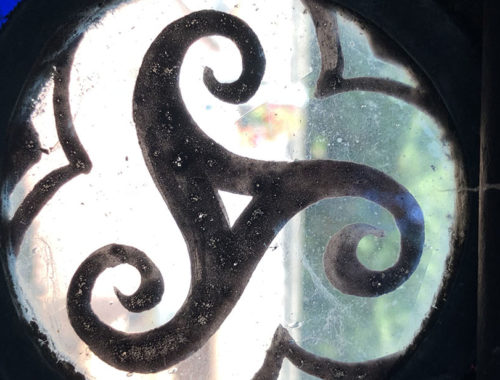What Should I Do (or Not Do) at My First Public Ritual?
What Should I Wear?
Unless there are guidelines about what to wear on the website or flyer where you found out about the ritual, chances are you can wear almost anything. I have seen people wear street clothes, ritual robes, sarongs, great kilts, bathrobes, lingerie, tie dye, caftans, head-to-toe leather, belly dance costumes, sarees, fetish wear, god or goddess costumes, animal costumes, fairy wings, armor and chain mail, nothing but body paint/glitter/henna designs/jewelry, and nothing at all. But, as with many things in life, just because you can do whatever you want doesn’t mean you should.
- DO wear clothing appropriate for the ritual venue (lighter clothing for a hot room full of people; heavier clothing for drafty or air-conditioned spaces; water, wind, or sun-resistant garb and appropriate footwear for outdoor rites).
- DO wear something that makes you feel good and gets you into a ritual frame of mind. Some Pagans keep special garb for rituals only, so whenever they put it on, they are preparing to be in sacred space. Others have special ritual jewelry.
- DO choose something that will continue to be comfortable if you have to wear it for several hours or stand for a long time.
- DO try to wear clothing that fits with the theme of the ritual, for example dark colors for Samhain and autumn colors for the Fall Equinox.
- DO take a bath or shower before ritual. Deodorant is everyone’s best friend.
- DON’T choose bulky/tight/voluminous/large/heavy garments that inhibit movement or anything that makes it hard for you to see.
- DON’T wear flammable clothing around candles.
- DON’T wear anything that’s likely to be distracting for you or others. It’s inconsiderate to wear your enormous Professor McGonagall hat, fairy wings, or horned Viking helm if it might block someone’s view, crowd people, or inhibit their movement.
- DON’T wear strong-smelling perfumes, aftershave, or body lotion. Many people are allergic, and a cloud of perfume will ruin the ritual for them. It’s hard to know when you’ve put on too much scent, so it’s better to go without. And don’t be that guy who douses himself in patchouli because he didn’t take a shower.
- DON’T wear something inappropriate, such as R-rated garb for a G-rated ritual where kids might be present; Native American regalia (especially if you’re not Native American); a “Jesus Saves” t-shirt; or Sponge Bob pajama bottoms.
What Should I Bring?
If the organizers specifically want to you bring anything, they usually outline that in the notice. Sometimes there’s a small entrance fee to help defray the costs of renting the venue. If there’s a potluck or “feast,” bring some food or paper plates or napkins. You might also want to bring a bottle of water if the ritual is going to be long, and a blanket to sit on, sunscreen, and bug repellent if it’s outside.
What Should I Expect in the Ritual?
- Some public rituals have a quick orientation beforehand. Be sure to attend.
- For years the joke has been that things start on “Pagan Standard Time,” which is anything from 20 minutes to an hour late. But lots of groups are trying to change that, so don’t assume you can saunter in late. On the other hand, try not to be impatient if you have to wait. Arrive on time, and if the ritual is delayed, use the time to meet new people or ask if you can help set up.
- Pagan rituals are very participatory. You may be asked to sing, dance, or repeat certain phrases.
- You may be blessed or “censed” with incense smoke before the ritual. If you have allergies, ask the person doing the blessing to skip you or keep the smoke away from your face.
- The ritual may involve a cleansing or purification of the ritual space with incense or salt water. Other times someone uses a broom to “sweep” all the bad stuff out.
- Rituals often take place in a circle drawn by the ritual leaders. The circle is sacred space, and once it’s sealed, it’s expected that people will not cross the boundary until the ritual is over. Even if there isn’t a circle, you still need to respect sacred space. For exceptions, see the Do and Don’t list below.
- There will be times when you don’t know what to do, and that’s okay. People who organize public ritual are used to having beginners around.
What Should I Make Sure to Do (or Not Do)?
- DO be part of the solution, not the problem, of “Pagan Standard Time.” Arrive at the ritual space a little early. The more people who do this, the more likely the ritual will start on time.
- DO pay attention to what’s happening around you and what other people are doing for clues about what you should be doing. If two or more participants who aren’t leading the ritual are doing something—such as turning to face a certain direction—you should do probably do it too.
- DO turn off your phone.
- DO participate as fully as possible. Don’t be what we like to call an “energy speed bump.”
- DO respect the group’s sacred space by quietly asking to be “cut out of the circle” if you have to leave a ritual where a circle has been drawn. Someone will make a “door” in the circle to let you out, which will disrupt the ritual less than if you broke the circle by crossing the boundary. If you feel uneasy about something in the ritual, it’s absolutely fine to ask to be cut out, but try not to do this unless you need to.
- DO thank your hosts after the ritual and offer to help clean up.
- DO tell your hosts if you notice someone acting in a sexually inappropriate way, especially if it’s toward a minor. Public rituals draw a wide variety of people, and some of them are dirtbags.
- DON’T plan to be somewhere immediately after the ritual in case it runs late.
- DON’T disrupt the ritual by side-talking or asking questions in the middle unless you have specifically been told you can do so. Save questions for afterward.
- DON’T touch anyone’s ritual tools or the altar or put anything on the altar without permission.
- DON’T walk counterclockwise in a ritual circle unless you are asked to.
- DON’T show up to ritual under the influence of alcohol or illegal drugs.
- DON’T take pictures of other participants without their permission or during the ritual.
- DON’T bring children or animals to the ritual unless you’re specifically told it’s okay.
- DON’T make assumptions about people based on what they’re wearing. The people wearing the weirdest clothes may have a lot to teach you. And clothing is not consent; if a person is wearing something revealing, it doesn’t give you the right to touch, proposition, or harass him or her.
If you have specific questions, it’s absolutely okay to contact the group organizing a public ritual ahead of time. If you found out about the ritual online or via a flyer or poster, chances are contact information was included—usually an email address or URL, but sometimes a phone number. If you found out about the ritual through a friend, he or she might already know the answers to your questions or have contact information for someone who does.




